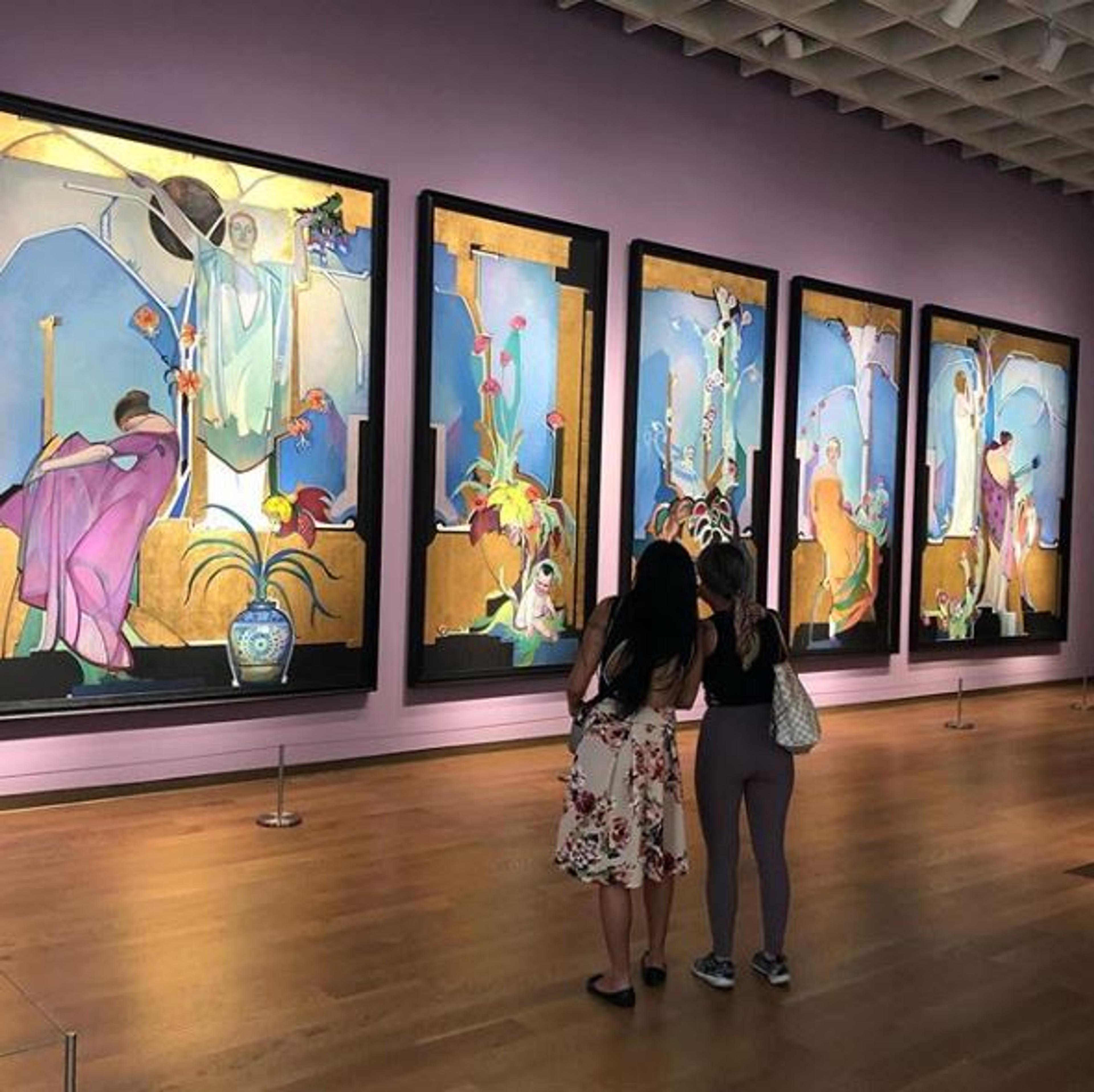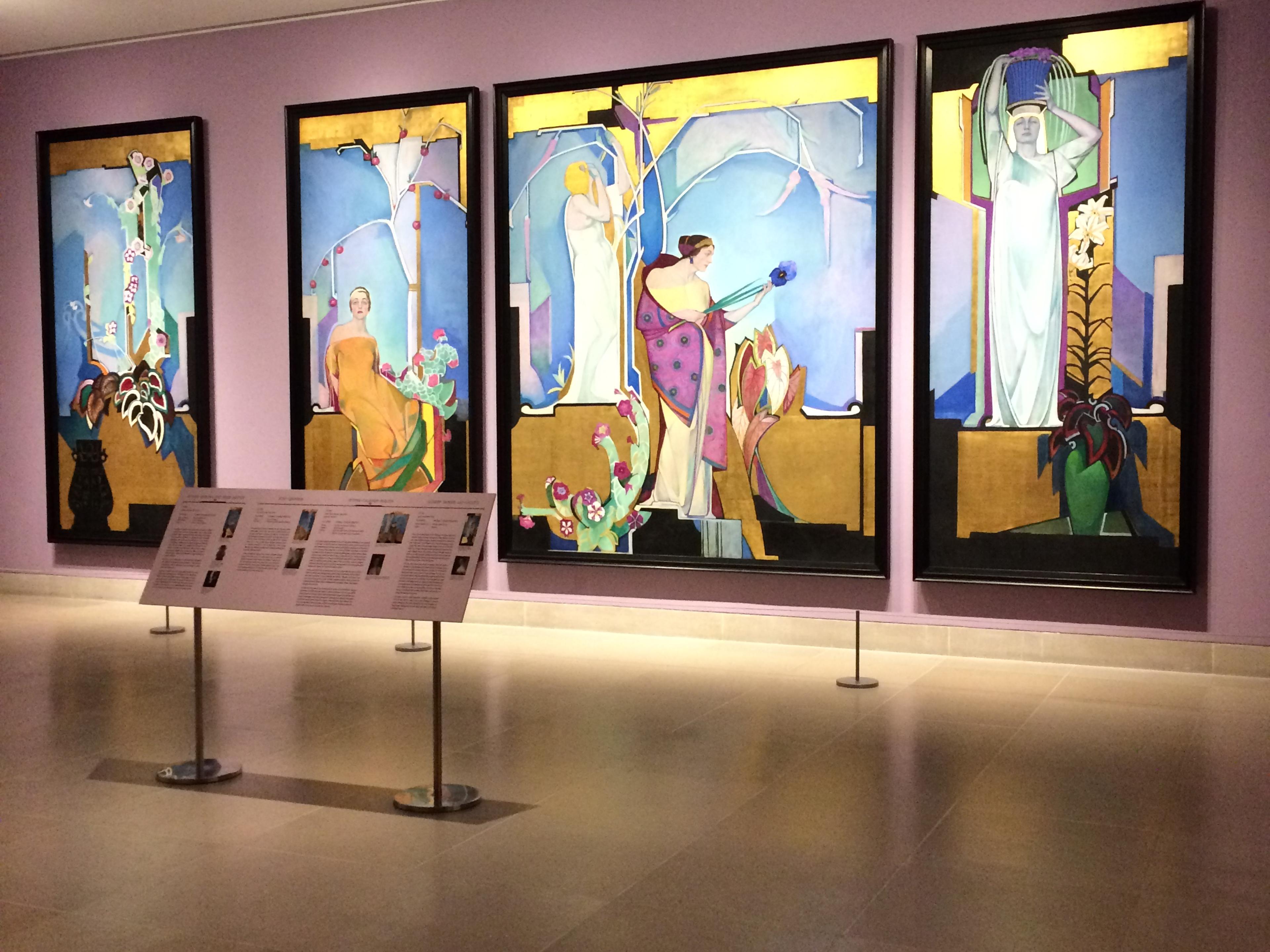Mennello Museum of American Art (MMAA) and Orlando Museum of Art (OMA)Partner Story

In Exaltation of Flowers Edward Jean Steichen at the Orlando Museum of Art
A Successful Collaboration
An unprecedented collaboration between the and the was born out of a barrier. The project began with a simple request from MMMA to Art Bridges to borrow series, In Exaltation of Flowers (1910-13). As the mechanics of the loan got underway, it was determined that some of the mural panels were too large to fit in the MMAA galleries. The team’s great disappointment spurred their creativity.
Just across a park, less than one-third of a mile away, stood OMA. Despite their proximity, the two museums had never had a specific reason to collaborate. Now they did! OMA’s building had galleries that could beautifully accommodate the monumental Steichen work. This fostered a collaboration full of opportunities that were mutually beneficial and mission-supporting, and that helped each organization reach aspirational goals.
From Loan to Exhibition
The project idea grew from a single Art Bridges loan at one museum to a full-scale exhibition at both institutions. The museums pitched to Art Bridges an exhibition that literally reached across the park to encompass both institutions and was fully collaborative. The additional space and potential of the two staffs spurred a project that leveraged each museum’s space and functions where they could easily join forces. Key connections were made in curatorial, interpretation, programming, and marketing.
A curatorial team with a member from each museum devised an exhibition concept that made good use of available space at the same time that it served as a catalyst for community engagement. The mural series was to be presented in a single, larger sized gallery at OMA, while Steichen photographs — directly related to the murals and generally modest in scale would go on view in the more intimate galleries of the MMAA. Yet another potential stumbling block appeared: where could they borrow Steichen photos, as neither institution had the artist’s work in their collection?

In Exaltation of Flowers Edward Jean Steichen at the Orlando Museum of Art

In Exaltation of Flowers Edward Jean Steichen at the Orlando Museum of Art
New Ideas and Programs
Throughout the project, MMAA and OMA kept in mind Art Bridges’ enthusiasm for experimentation and community engagement. Both museums and the Foundation were excited by the opportunity to inaugurate in-gallery experiences using materials in Spanish and Braille. Additionally, the museums created a fully integrated and targeted marketing plan that served both organizations’ desire to reach new audiences —i n this case, more rural community members who commute into the city of Orlando without generally visiting the museum.
Mass transit — buses and trains — literally became the vehicle by which news of the exhibition was spread. Programming took place at each museum and efforts were coordinated to encourage participation by new audiences, especially younger people and first-time visitors. To that end, the museums experimented with more hands-on or participatory offerings.
Among the most successful events were Family Fun Days that included botanical painting, gold-leafing, and photography workshops, which appealed to garden and flower lovers as well as creatives. A more diverse group of guests was noted, some of whom shared they had never been to the museum before. Tableau vivants, which were a collaboration among a dance company, a florist, and theater company, were presented at OMA as an experiment to see if guests could be lured into the galleries on a festival day where most people stayed in non-art spaces.
Impact
MMAA and OMA were very pleased with the outcomes of this project and some valuable lessons were learned. The community noticed and applauded the two-museum collaboration. The mix of painting and photography in the exhibition and programs helped guests reconsider what might be called art (i.e. is photography art?) and notice a medium (painting) they were less familiar with.
The engagement of the Spanish-speaking community was considered a real success, with visitor feedback giving high marks for the focused marketing and translated materials. In all the programs, taking a more interdisciplinary approach clearly expanded their audiences in number and type. High school and college students were particularly drawn to the photography workshops. Local artists were partners on many of the programs, which forged new or deeper relationships with the museums.
Both museums were interested in the success of some programs where the attendees were not the audience they were targeting or expecting. As an example, micro-targeting — ie, to garden clubs for an ikebana workshop — was generally not productive. In the end, both museums found the collaboration with each other and other museums outside of Orlando to be extremely rewarding and vital to the success of the project. They look forward to applying more of this approach to future projects.
Why We Love This Project
We love that CSUN Art Galleries inspires students to use their voices in creative and hands-on ways to build greater awareness of modern-day social inequities. Further, we love that they provided concrete resources that enabled ease, familiarity, and excitement towards voting. This project exemplifies the Art Galleries prioritization of civic engagement and access through low-barrier and creative experiences.